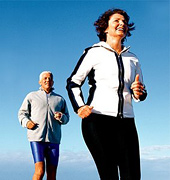To Your Health
March, 2007 (Vol. 01, Issue 03) |
|
|
Staying Active While Aging
By Julie Engebretson
Fitness matters, especially as we age. Here's a refresher course on the importance of regular physical activity and its role in preventing disease and injury in your later years.
It's no secret that exercise is important, especially as we age. We learn this early in life: Young people throughout America are required to take physical education classes from first grade through high school, as has been the case for decades. But has the "get moving" message from those P.E. classes stayed with you?
As you turned your tassel from left to right on graduation day, you may have said goodbye to coaches, gym lockers and formal physical education, but commencement "exercises" shouldn't be your last!
Among the many factors that do a body good, maintaining cardiovascular fitness and lean muscle mass while aging is somewhere at the top of the list. Challenging the natural loss of vitality over our lifetime with consistent physical activity not only keeps excess weight off, but also boosts immunity and mood, and has been shown to promote heart health, delay or prevent osteoporosis and even prevent some types of cancer. But instead of another shaming, finger-waving reminder that you ought to hit the gym more often, perhaps a closer look at the very real consequences of inactivity will provide the motivation you need to get moving.
Inactivity: The Heart Of The Matter.
 Physical activity or inactivity affects heart health more than you may be aware. More than just a pump, the human heart is responsible for nourishing every cell in the body, carrying vital materials such as oxygen and glucose throughout the body, while waste and unnecessary products are removed. But as we age, the heart's job can be made much more difficult. Decades of poor eating and inactivity allow plaque (deposits of fatty substances, cholesterol, calcium and other matter) to plaster the walls of arteries that supply blood to the heart muscle. This process considerably narrows the passageways through which blood must pass.
Physical activity or inactivity affects heart health more than you may be aware. More than just a pump, the human heart is responsible for nourishing every cell in the body, carrying vital materials such as oxygen and glucose throughout the body, while waste and unnecessary products are removed. But as we age, the heart's job can be made much more difficult. Decades of poor eating and inactivity allow plaque (deposits of fatty substances, cholesterol, calcium and other matter) to plaster the walls of arteries that supply blood to the heart muscle. This process considerably narrows the passageways through which blood must pass.
A unique trait of the cardiac muscle is that, unlike skeletal muscles, the heart cannot vary the amount of force or energy exerted from beat to beat. In keeping with our fitness theme, lying back on the bench press, the average man is capable of completing 10 repetitions fairly quickly, when lifting only the bar. But adding 50 pounds of resistance to the bar would force him to slow his rate of exertion considerably in order to complete 10 repetitions. In contrast, the heart gives 100 percent every time, contracting with all of its force approximately 72 times per minute, every hour of every day. While this characteristic of the cardiac muscle ensures constant and consistent life-giving nourishment to all parts of the body, the same trait can be harmful, even deadly, as the heart pumps with all its force against the increased resistance of a clogged artery. Imagine bench-pressing 300 pounds with the same force and rapidity exerted when lifting the unweighted bar! Unable to adjust to the added resistance, the heart muscle can give out under the strain, resulting in a heart attack or sudden cardiac arrest.

